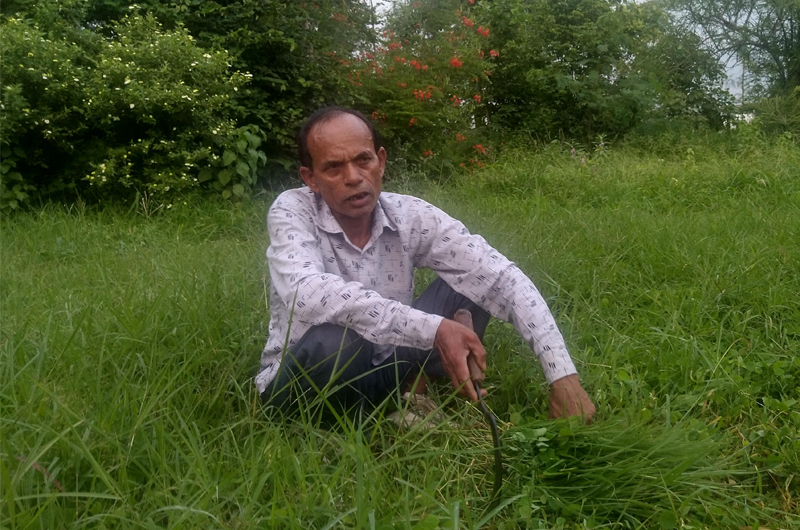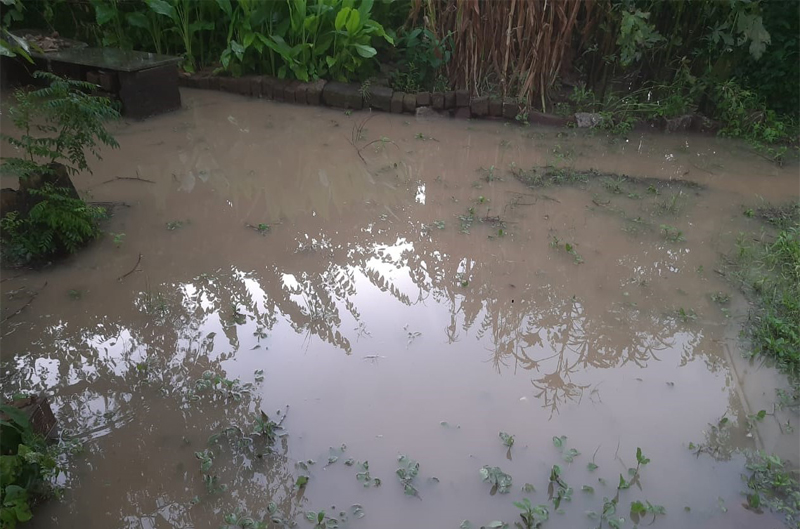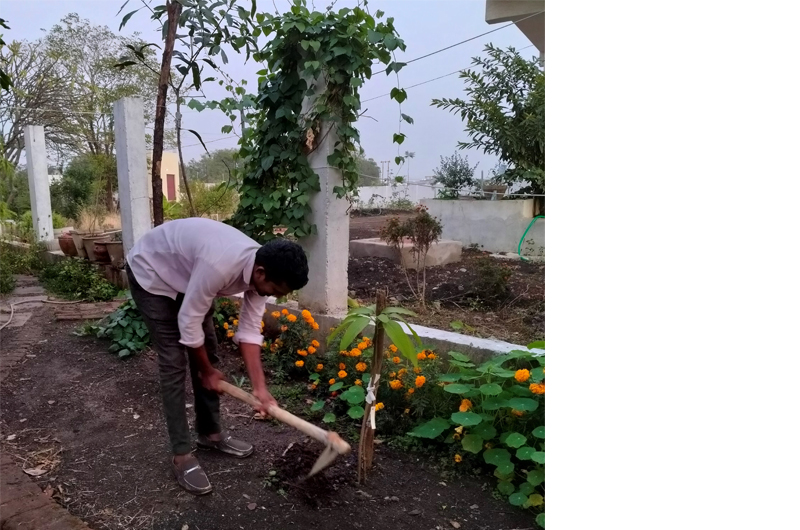The Madhya Pradesh Government has taken many steps to make rapid strides in agriculture. Three interventions particularly stand out – expanded irrigation, a strong procurement system put in place for wheat along with bonus over the minimum support price for wheat, and all-weather roads to connect farmers to markets, says Sushmita Malaviya. However, changing monsoon patterns and erratic rainfall have been affecting the soya bean crop, the cash crop for farmers in Madhya Pradesh. Here is her story
On the face of it farmers – both women and men farmers on the outskirts of Bhopal, Madhya Pradesh – agree that more land has come under agriculture. Kailash Khushwaha, in Village Ratibad, Bhopal, a farmer who also tends to two institutional gardens within the village, says, “Since water pumps were introduced for agricultural activities, thus facilitating access to water, there has been an increase in agricultural activities over the years. Alongside this, the availability of tractors has helped reap increased crops.”
Chandrabala Verma, who lives in the same village, points out that lands that had been lying barren for years have also been taken under agriculture by the wealthier farmers as they now have access to water and other facilities. Her parents own 2.50 acres of land in Khokrakala Village in Shajapur District of Madhya Pradesh. With better facilities gradually being available she has seen them expand their agricultural activities too. “My parents now grow crops twice a year – soya bean and later wheat, garlic, channa, lentils (musur) and potatoes. They grow up to 30 quintals of soya bean and wheat.” Over the years, due to the access to water and more agricultural support, her parents have been able to bring more fallow land under agriculture too. Thereby getting produce up to 40 quintals of soya bean and 50 quintals of wheat.
This is in line with the many measures taken by the Madhya Pradesh State Government to make rapid strides in agriculture. Three interventions stand out particularly – expanded irrigation, a strong procurement system put in place for wheat along with bonus over the minimum support price for wheat and all-weather roads to connect farmers to markets. Reflecting on farming in Mallipura, Sehore Kailash explains that there has been a change. “We used to grow two crops – soya bean and wheat. From the acre of land, we would grow 15 quintals of wheat. Today, we get about 10 to eight quintals. Due to changing monsoon patterns we are growing only one crop.” Chandrabala too says, “Over the years the soya bean crop in Shajapur has been erratic. While we were able to harvest 30 quintals in 2024, in 2023 my parents could harvest only 10 quintals as there was excess rain that year.”
Radhyashyam and his family work on 10 acres of land in Silkhedha, Bilkisganj, District Bhopal. Most of the women in the family too contribute to agricultural labour. They grow wheat, channa and peas during the kharif season and soya bean, maize, jowar, laltur, paddy and groundnut during the rabi season. “In 2022 the rains were good and helpful for us. The next year, 2023, we got a good average from maize. However, it’s the continuous rain and sometimes no rain situation that affects soya bean crops,” he explains. Recalling the most recent time when his crop was affected, Radhyashayam says it was in 2015, when his moong (lentils) crop was hit.

care of a private garden in Village Ratibad 100 km away. He brings all his agricultural knowledge when he works as gardener.
Kailash adds, “More recently, we were faced with unseasonal dew during the kharif season which affected wheat, channa, vegetables, potatoes and eggplant,” referring to his 2024 crop cycle. Indu Murty, Center for Study of Science, Technology and Policy (CSTEP), which works with governments and institutions to develop solutions using science and technology, emphasises that “India is still a rain-fed country. Any change in the monsoons, affects the crop seeding, flowering and yields. The quality of crops are changing therefore affecting the income of farmers.”
Madhya Pradesh has consistently been increasing its agricultural output. In 2024, the state topped India with its soya bean production. For farmers here, soya bean has long been the cash crop that has pulled them through –increasing their economic status. With the changing monsoon patterns, the sensitive crop is causing concern to farmers like Radhyshyam, Kailash and Hukum Verma. “Soya bean needs a gentle drizzle and when they are germinating they also need sunlight. When there is excess rain they do not fruit,” explains Radhyashyam. In June 2024 when they sowed soya bean, there was a gap of 15 days in the monsoons that disrupted its growth. “Soya bean is an important crop for us as it is sold and that is our annual source of income. We keep the maize for sustenance,” he adds.
Ankita Bhatkhande of Asar Social Impact Advisors says that their work in Nagpur, Central India, with women farmers revealed that they followed the nakshatra (lunar mansions or stations) system and the communities traditionally make their preparations for agriculture-related activities. Nakshatras are used by farmers to determine the most auspicious times for various agricultural activities such as sowing, planting and harvesting, based on the lunar cycle. Today, such predications are facing challenges. “The nakshatra calendar is essentially a sowing and harvesting timeline for farmers. However, today, these traditional markers are not aligning with the changing monsoon patterns. Following this traditional pattern, when women are all set to sow or harvest they are faced with unseasonal heat, rain sometimes extreme which disrupts the agricultural patterns. These have serious impacts on their income planning and household budgets,” she explains.
Farmers in Madhya Pradesh, too, have deep insights in traditional signals for agricultural practices. “When birds – titari – call out we know there is going to be a good rain. When the Saras lays eggs upright there will be good rains. If they are laid sidewise, there are less rains. There is a cycle we have been following – every two years of rain will be followed by a third year with no rain,” explains Kailash. When Radhashyam was asked how his family is coping with the crop disruption, he just says, “There is no income, it’s very difficult.” He has completed his graduation and, to supplement his family’s income, he teaches children in the village. Once a week, he takes up additional farm-related work that is 13 km away from his home, to tend to a private kitchen garden.
What then are the farmers’ coping mechanisms? Alongside keeping track of his agricultural land in Sehore, Kailash also works in a college and tends a private garden in Village Ratibad that is 100 km away. He brings all his knowledge about agriculture when he works as gardener, “Nowadays in the college where I work, they give us some guidance on how to work on the quality of the soil so that we can plant the trees,” he says referring to the rocky nature of the land, “you will see that there are no big trees in Ratibad because the stones below do not let the trees grow.”
Chandrakala remembers her parents suffering a soya bean crop failure in 2000. She recalls that since her father had additional income from a country liquor business the family managed. However, she remembers her mother being thrifty, “making one meal of dal a day which had all the vegetables in it without using any cooking oil… these were served along with jowar or maize rotis.” In the same village, discussions with other farmers about soil quality are met with a frustrated, “What to say, there is really not much discussion on quality of soil – it’s copra (soil largely composed of soft stone).”

Familiar with agricultural work, Sunita Maran’s family in Silkheda Village in adjoining Berasia District tills 10 acres of land – to grow soya bean (rabi) and wheat (kharif). She clearly remembers that 35 years ago the family would depend on the monsoons for their crops and used only urea and cow dung to replenish their soil. “I used to be in the field every day, weeding and sowing,” she says. Sunita recalls that a crop failure – in this case excess rain during the growth of the soya bean – would mean that she, her sister and brother and her parents would work as agriculture labourers for Rs 10 a day.“For agricultural work we were dependent only on the monsoons and ponds. The water canals came much later,” she says.
Kailash recalls that earlier they would plough the land with a bullock cart, using less water. “There was less crop but they were sustainable. We only used cow dung and urea. Today the manure includes Diammonium phosphate and urea. We have become dependent on these, even though we know that the quality of our soil is going down.”
Now a widow, 45-year-old Sunita Maran supports her family in Ratibad Village with the income she makes selling milk. She bought her first cow 24 years ago. As the cows birthed, she continued selling milk and gifting family members the calves. The feed for the cows would be green grass from the fields and dry straw that she would source for Rs 2000 to 3000 for a quintal. Today, she pays Rs 20000 for a quintal, which she tries to buy as soon as the wheat is cut – when it is cheaper to buy.
Madhya Pradesh’s agricultural GDP increased 8.1 per cent per annum during 2005-06 to 2016-17, surpassing Gujarat’s 6 per cent agricultural growth in the same period. The last three years have been even more spectacular: agricultural GDP increased 11.8 per cent per annum. However, based on their experience over the years, fames have accumulated wide knowledge about agricultural practices which the government would do well to make use of.
(The writer is a WomenLift Health Global Fellow 2024. This report relies on information collected during her leadership project on the environment, climate change and women’s health.)



 from Webdoux
from Webdoux